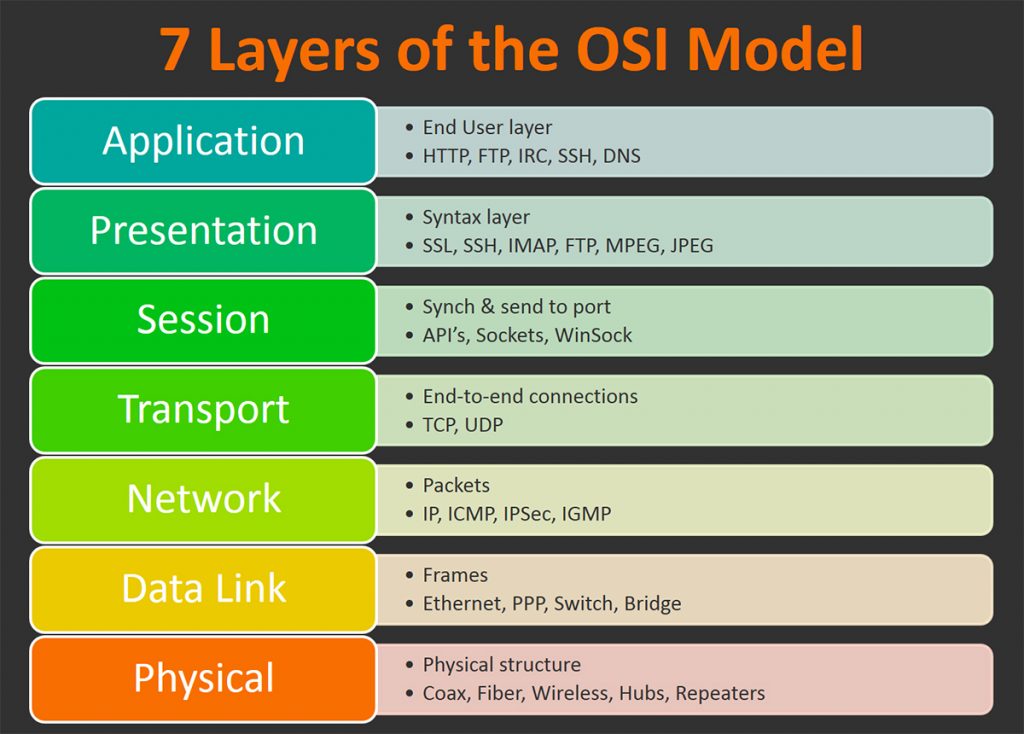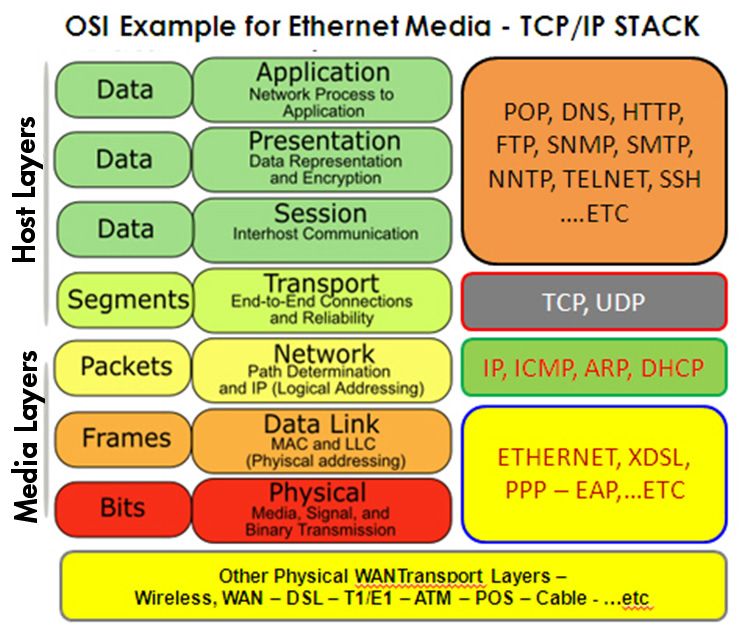Unlike passive information gathering, which involves an intermediate system for gathering information, active information gathering involves a direct connection with the target.The client probes for information directly with the target with no intermediate system in between. While this technique may reveal much more information than passive information gathering, there’s always a chance of security alarms going off on the target system. Since there’s a direct connection with the target system, all the information requests would be logged and can later be traced back to the source. The following diagram depicts active information gathering where the client is directly probing the target system:

OSI Model / TCP/IP Model
The Open Systems Interconnection model (OSI model) is a conceptual model that characterises and standardises the communication functions of a telecommunication or computing system without regard to its underlying internal structure and technology. Its goal is the interoperability of diverse communication systems with standard communication protocols.
The TCP/IP model is a concise version of the OSI model. It contains four layers, unlike seven layers in the OSI model. The layers are:
- Process/Application Layer
- Host-to-Host/Transport Layer
- Internet Layer
- Network Access/Link Layer
Difference between TCP/IP and OSI Model:
| TCP/IP | OSI |
|---|---|
| TCP refers to Transmission Control Protocol. | OSI refers to Open Systems Interconnection. |
| TCP/IP has 4 layers. | OSI has 7 layers. |
| TCP/IP is more reliable | OSI is less reliable |
| TCP/IP does not have very strict boundaries. | OSI has strict boundaries |
| TCP/IP follow a horizontal approach. | OSI follows a vertical approach. |
| TCP/IP uses both session and presentation layer in the application layer itself. | OSI uses different session and presentation layers. |
| TCP/IP developed protocols then model. | OSI developed model then protocol. |
| Transport layer in TCP/IP does not provide assurance delivery of packets. | In OSI model, transport layer provides assurance delivery of packets. |
| TCP/IP model network layer only provides connection less services. | Connection less and connection oriented both services are provided by network layer in OSI model. |
| Protocols cannot be replaced easily in TCP/IP model. | While in OSI model, Protocols are better covered and is easy to replace with the change in technology. |
Layer 2 Discovery – Arping / netdiscover
Layer 2 tools can act faster than layer 3 but it can not go to another network. The packets stays in the same network.
┌──(root💀kali)-[~] └─# arping 192.168.2.1 -c 3 1 ⨯ ARPING 192.168.2.1 60 bytes from 00:78:cd:00:fd:f4 (192.168.2.1): index=0 time=4.034 msec 60 bytes from 00:78:cd:00:fd:f4 (192.168.2.1): index=1 time=2.622 msec 60 bytes from 00:78:cd:00:fd:f4 (192.168.2.1): index=2 time=3.788 msec --- 192.168.2.1 statistics --- 3 packets transmitted, 3 packets received, 0% unanswered (0 extra) rtt min/avg/max/std-dev = 2.622/3.481/4.034/0.616 ms ┌──(root💀kali)-[~] └─#
┌──(root💀kali)-[~] └─# netdiscover -i eth0 -r 192.168.2.0/24 Currently scanning: Finished! | Screen View: Unique Hosts 172 Captured ARP Req/Rep packets, from 30 hosts. Total size: 10320 _____________________________________________________________________________ IP At MAC Address Count Len MAC Vendor / Hostname ----------------------------------------------------------------------------- 0.0.0.0 08:ea:40:f8:48:a2 48 2880 SHENZHEN BILIAN ELECTRONIC CO.,LTD 0.0.0.0 08:ea:40:fc:48:f3 46 2760 SHENZHEN BILIAN ELECTRONIC CO.,LTD 0.0.0.0 08:ea:40:f8:44:63 36 2160 SHENZHEN BILIAN ELECTRONIC CO.,LTD 192.168.2.1 00:78:cd:00:fd:f4 1 60 Ignition Design Labs 192.168.2.2 08:cc:68:40:71:c1 1 60 Cisco Systems, Inc 192.168.2.4 00:0c:29:1b:b7:e1 1 60 VMware, Inc.
┌──(root💀kali)-[~] └─# netdiscover -p Currently scanning: (passive) | Screen View: Unique Hosts 307 Captured ARP Req/Rep packets, from 12 hosts. Total size: 18420 _____________________________________________________________________________ IP At MAC Address Count Len MAC Vendor / Hostname ----------------------------------------------------------------------------- 0.0.0.0 08:ea:40:f8:44:63 94 5640 SHENZHEN BILIAN ELECTRONIC CO.,LTD 192.168.2.155 24:be:05:e2:40:8f 13 780 Hewlett Packard 0.0.0.0 08:ea:40:f8:48:a2 82 4920 SHENZHEN BILIAN ELECTRONIC CO.,LTD 0.0.0.0 08:ea:40:fc:48:f3 82 4920 SHENZHEN BILIAN ELECTRONIC CO.,LTD 0.0.0.0 00:78:cd:03:d3:00 6 360 Ignition Design Labs 192.168.2.163 00:78:cd:03:d3:00 2 120 Ignition Design Labs 192.168.2.157 5c:cf:7f:73:26:55 13 780 Espressif Inc. 0.0.0.0 00:78:cd:01:05:b8 6 360 Ignition Design Labs 0.0.0.0 00:78:cd:03:d7:40 4 240 Ignition Design Labs
Layer 3 Discovery – Ping
Layer 3 tools can be used to discover different networks.
- Use traceroute mode (–traceroute), be verbose (-V) in ICMP mode (-1) against the target (www.xxx.com):
- root@kali:~# hping3 –traceroute -V -1 www.xxx.com
- -q: brief output. -c: packets numbers. -d:packet site. -S:SYN packets. -p:Port Number. -w:tcp window size. –flood: shoot at discretion, replies will be ignored. –rand-source: hide source ip using a fake random ip.
- hping3 -q -c 10 -d 120 -S -w 64 -p 80 –flood –rand-source www.xxx.com
- fping -g 192.168.2.0/24 -c 1 | grep ms > results.txt
Layer 4 Discovery – Nmap
According to the official Nmap website –
Nmap Target Selection
| Scan a single IP | nmap 192.168.2.1 |
| Scan a host | nmap www.test.com |
| Scan a range of IPs | nmap 192.168.2.1-20 |
| Scan a subnet | nmap 192.168.2.0/24 |
| Scan targets from a text file | nmap -iL list-of-ips.txt |
Nmap Port Selection
| Scan a single Port | nmap -p 22 192.168.2.1 |
| Scan a range of ports | nmap -p 1-100 192.168.2.1 |
| Scan 100 most common ports (Fast) | nmap -F 192.168.2.1 |
| Scan all 65535 ports | nmap -p- 192.168.2.1 |
Nmap Port Scan types
| Scan using TCP connect | nmap -sT 192.168.2.1 |
| Scan using TCP SYN scan (default) | nmap -sS 192.168.2.1 |
| Scan UDP ports | nmap -sU -p 123,161,162 192.168.2.1 |
| Scan selected ports – ignore discovery | nmap -Pn -F 192.168.2.1 |
Service and OS Detection
| Detect OS and Services | nmap -A 192.168.2.1 |
| Standard service detection | nmap -sV 192.168.2.1 |
| More aggressive Service Detection | nmap -sV –version-intensity 5 192.168.2.1 |
| Lighter banner grabbing detection | nmap -sV –version-intensity 0 192.168.2.1 |
Nmap Output Formats
| Save default output to file | nmap -oN outputfile.txt 192.168.2.1 |
| Save results as XML | nmap -oX outputfile.xml 192.168.2.1 |
| Save results in a format for grep | nmap -oG outputfile.txt 192.168.2.1 |
| Save in all formats | nmap -oA outputfile 192.168.2.1 |
Digging deeper with NSE Scripts
| Scan using default safe scripts | nmap -sV -sC 192.168.2.1 |
| Get help for a script | nmap –script-help=ssl-heartbleed |
| Scan using a specific NSE script | nmap -sV -p 443 –script=ssl-heartbleed.nse 192.168.2.1 |
| Scan with a set of scripts | nmap -sV –script=smb* 192.168.2.1 |
A scan to search for DDOS reflection UDP services
| Scan for UDP DDOS reflectors | nmap –sU –A –PN –n –pU:19,53,123,161 –script=ntp-monlist,dns-recursion,snmp-sysdescr 192.168.2.0/24 |
HTTP Service Information
| Gather page titles from HTTP services | nmap –script=http-title 192.168.2.0/24 |
| Get HTTP headers of web services | nmap –script=http-headers 192.168.2.0/24 |
| Find web apps from known paths | nmap –script=http-enum 192.168.2.0/24 |
Detect Heartbleed SSL Vulnerability
| Heartbleed Testing | nmap -sV -p 443 –script=ssl-heartbleed 192.168.2.0/24 |
IP Address information
| Find Information about IP address | nmap –script=asn-query,whois,ip-geolocation-maxmind 192.168.2.0/24 |
Scapy
>>> ARP().display()
###[ ARP ]###
hwtype= 0x1
ptype= IPv4
hwlen= None
plen= None
op= who-has
hwsrc= 00:0c:29:fc:11:ce
psrc= 192.168.2.20
hwdst= 00:00:00:00:00:00
pdst= 0.0.0.0
>>> sr1(ARP(pdst="192.168.2.1"))
Begin emission:
Finished sending 1 packets.
*
Received 1 packets, got 1 answers, remaining 0 packets
<ARP hwtype=0x1 ptype=IPv4 hwlen=6 plen=4 op=is-at hwsrc=00:78:cd:00:fd:f4 psrc=192.168.2.1 hwdst=00:0c:29:fc:11:ce pdst=192.168.2.20 |<Padding load='\x00\x00\x00\x00\x00\x00\x00\x00\x00\x00\x00\x00\x00\x00\x00\x00\x00\x00' |>>
>>>
>> IP().display()
###[ IP ]###
version= 4
ihl= None
tos= 0x0
len= None
id= 1
flags=
frag= 0
ttl= 64
proto= hopopt
chksum= None
src= 127.0.0.1
dst= 127.0.0.1
\options\
>>> ICMP().display()
###[ ICMP ]###
type= echo-request
code= 0
chksum= None
id= 0x0
seq= 0x0
>>> sr1(IP(dst="192.168.2.1")/ICMP(),timeout=1)
Begin emission:
Finished sending 1 packets.
*
Received 1 packets, got 1 answers, remaining 0 packets
<IP version=4 ihl=5 tos=0x0 len=28 id=50232 flags= frag=0 ttl=64 proto=icmp chksum=0x3143 src=192.168.2.1 dst=192.168.2.20 |<ICMP type=echo-reply code=0 chksum=0xffff id=0x0 seq=0x0 |<Padding load='\x00\x00\x00\x00\x00\x00\x00\x00\x00\x00\x00\x00\x00\x00\x00\x00\x00\x00' |>>>
>>> TCP().display()
###[ TCP ]###
sport= ftp_data
dport= http
seq= 0
ack= 0
dataofs= None
reserved= 0
flags= S
window= 8192
chksum= None
urgptr= 0
options= []
>>> sr1(IP(dst="192.168.2.1")/TCP(flags="S",dport=80),timeout=1)
Begin emission:
Finished sending 1 packets.
.*
Received 2 packets, got 1 answers, remaining 0 packets
<IP version=4 ihl=5 tos=0x0 len=44 id=0 flags=DF frag=0 ttl=64 proto=tcp chksum=0xb566 src=192.168.2.1 dst=192.168.2.20 |<TCP sport=http dport=ftp_data seq=3654116272 ack=1 dataofs=6 reserved=0 flags=SA window=29200 chksum=0x62bd urgptr=0 options=[('MSS', 1460)] |<Padding load='\x00\x00' |>>>
>>>
from Blogger http://blog.51sec.org/2021/05/pen-test-lab-3active-information.html



